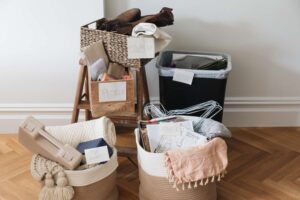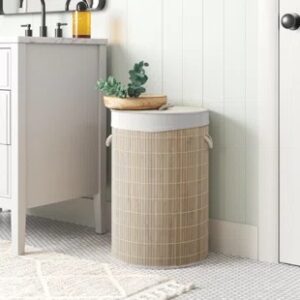
Decluttering in progress
BY DEBRA KEEFER RAMAGE
Spring thoughts
A project a lot of people are undertaking this spring is to make their home as close to zero waste as possible. It makes a lot of sense. News from the ever-growing Great Pacific Garbage Patch is troubling, Minneapolis environmentalists are pressuring Hennepin County to close the HERC incinerator, and new companies are making a lot by promising to take practically anything to recycle – for a fee, of course. And this is related to the long-running craze for decluttering. It all reduces down to a simpler day-to-day life.
Approaching zero waste – the philosophy, the resources

Bulk products at Tare Market
The first thing to say about zero waste is that of course it will never mean zero. Waste cycles are an inseparable part of life cycles. To live on the earth with no imprint at all, you would have to be a ghost. But if absolute zero waste is unnatural, so too is having so much overproduction and waste that the vast oceans are clogging up with plastic objects. So zero waste is shorthand for trying to reduce your waste output to a manageable level.
The philosophy includes less primary consumption, less over-consumption (i.e., buying more than you can use for whatever reason), and buying more thoughtfully, which means fewer disposables, more reusables, and less packaging. And also that more of the packaging you do consume is biodegradable, compostable or at least nontoxic. Another way to reduce primary consumption is to remember that needs or wants can be satisfied in ways that don’t involve buying at all. Consider and use the gift economy, the stuff your friends are going to throw away, foraging, gardening, and DIY with something you already own.
Since a key to a lot of this is reducing plastics and other cheap-but-toxic disposables, it can be more expensive in individual cases to do zero waste. But if you’re not also reducing primary consumption,

Woven laundry hamper
which will offset these higher costs with savings, you’re doing it wrong anyway. Here are a few quick examples of a more expensive, less wasteful choice, offset by a less expensive, less wasteful choice.
• In the bathroom, stop buying plastic toothbrushes that last three months and are thrown out. Buy bamboo replaceable head toothbrushes which are more expensive but less wasteful.
• In the bathroom, stop throwing out plastic pump bottles when the liquid hand soap runs out. Instead refill the bottle by making your own from old bar soap scraps, or buying a concentrate, or buying hand soap in bulk without packaging at the co-op or zero-waste shop, thus saving money too.
• In the kitchen, stop buying plastic wrap, drastically reduce the amount of Ziploc bags you buy by washing and reusing them, and buy a small number of silicone non-disposable food storage bags, which are more expensive but less wasteful.
• In the kitchen, stop buying premade frozen bean burgers in disposable plastic packaging, and make your own bean burgers (or mac and cheese,

Small house with small kids, decluttered
or buffalo wings) in bulk, from scratch, freezing them in the silicone bags, glass storage bowls, or reused Ziplocs, thus saving money too.
Another way to reduce plastic is to stop using plastic storage bins, tools, etc. and when you need a new storage object or cleaning tool, buy or make a natural one that will decompose when you throw it out. I am old enough to remember when all laundry baskets were actually baskets, i.e., woven willow or something similar. This will also improve the aesthetics of your home.
For storing clothes, you can use wood, cardboard, canvas or woven willow instead of plastic. For a bucket, or a trash or composting receptacle, use metal; for a mop, use a string mop with a wooden handle. Use natural brushes, natural sponges and soft cotton rags.
Resources:

Composting in the garden
• Tare Market in Minneapolis and similar zero-waste shops.
• Bulk section in your food co-op; water filter pitcher and steel water bottle instead of plastic bottled water, also from co-op (or grocer).
• Other retail bulk sales such as at environmentally conscious health and beauty retailers, garden centers and hardware stores.
• Online shopping – Amazon, Dropps, etee.com, Grove, Vermont Country Store, Duluth Trading Company and hundreds more.
• Zero-waste bloggers and websites for ideas and recommendations.
• Cloth diaper services, if you struggle to keep up with your own laundering of cloth diapers.
• Books (you won’t believe how many there are – but borrow them from the library or buy them as ebooks).
• When remote shopping or subscription buying online, ask about packaging and shipping, and choose the most waste-reducing.
• City, county or private recycling and composting services.
• Community education classes in zero waste and DIY solutions.
• Thrift stores, vintage stores, Buy Nothing groups on Facebook, the Really Really Free Market in Minneapolis, alleys and curbs (both for reducing new consumption and for recycling your own stuff to keep it out of the waste stream).
Decluttering your home – the philosophy, the resources
I was just as overwhelmed by the amount of material, both online and in books and magazines, about decluttering. One thing decluttering experts love to do is make rules. Strict adherence to these is rather silly, in my view, but I offer a representative sample as a way to spark your own motivation (and mine) to declutter.
• The 20/20 rule – if something can be replaced with $20 or less in 20 minutes or less, you don’t need to keep it.
• The 90-90 rule – if you haven’t used it in the past 90 days, and won’t need it in the next 90 days, don’t keep it. (Not sure this applies to Minnesota. We would throw out our boots every summer!)
• The five-second rule – hold the thing and ask yourself when you last used it; if you can’t remember in five seconds, don’t keep it.
• The four-box rule – you have four boxes labeled Toss/Give/Keep/Store. Sort into boxes. If you don’t have storage and can’t afford to rent storage, use only the first three.
• Six rules for decluttering – 1. Start simple; 2. Document your nostalgia; 3. Lose duplicates; 4. Nix the guilt; 5. Stop bringing so much home; and 6. Everything in its place.
• What NOT to do – 15 more rules for decluttering. But 15 is too many! However, here is my favorite: Don’t focus on what you’re losing, focus on what you’re keeping.

Zero-waste products
These aren’t exactly rules, but are rule-like structures and lists.
• The 80/20 rule or Pareto Principle applied to decluttering (OK, so this applies to clutter certainly) – you only use 20% of what’s in your space 80% of the time. But if you get rid of the 80% you don’t use, then what? Does the rule cease to exist, or do you start using less again, and repeat until you’re sitting by the road with a begging bowl?
• Five types of clutter (I found this one the most helpful) – see link below.
• What clutter experts never have in their bedrooms – tech devices, books, paperwork, out of season clothes, under-bed storage, old health and beauty items, clothing piles.
Links to resources
–littlemissorganised.com.au/5-types-of-clutter
–unep.org/news-and-stories/story/cities-embrace-zero-waste-philosophy-amidst-torrents-trash
–epa.gov/transforming-waste-tool/how-communities-have-defined-zero-waste
–mspmag.com/arts-and-culture/how-to-start-composting
–thrivemarket.com/blog/how-to-reduce-waste-in-every-room
–facebook.com/BuyNothingProject
























